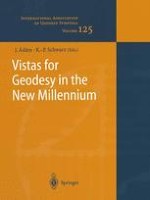It was in September 1906 that the predecessor of the IAG, the 'Internationale Erdmessung', th organized the 15 General Assembly at the Hungarian Academy of Sciences in Budapest. It was 95 years later, in September 2001, that the IAG returned to this beautiful city to hold its Scientific Assembly, IAG 2001, in the historical premises of the Academy. The meeting took place from September 2-7, 2001 and continued the tradition of Scientific Assemblies, started in Tokyo (1982) and continued in Edinburgh (1989), Beijing (1993) and Rio de Janeiro (1997). Held every four years at the midpoint between General Assemblies of the IAG, they focus on giving an integrated view of geodesy to a broad spectrum of researchers and practitioners in geodesy and geophysics. The convenient location of the main building of the Hungarian Academy in downtown Budapest and the superb efforts of the Local Organizing Committee contributed in a major way to the excellent atmosphere of the meeting. As at previous meetings, the scientific part of the program was organized as a series of symposia which, as a whole, gave a broad overview of actual geodetic research activities. To emphasize an integrated view of geodesy, the symposia did not follow the pattern of the IAG Sections, but focussed on current research topics to which several IAG Sections could contribute. Each symposium had 5 sessions with presented papers and poster sessions on two consecutive days.
